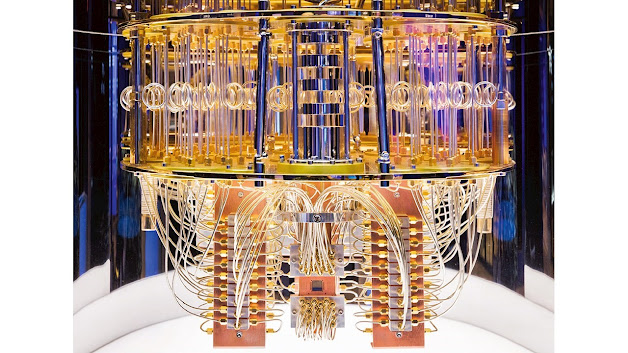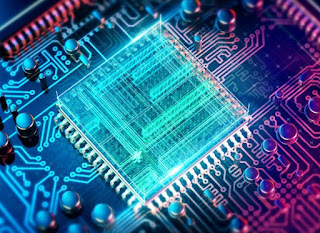How do Quantum Computers Work?
How do Quantum Computers Work?
A traditional computer operates using classical bits; these bits could be one or zero; however, Quantum Computer utilizes quantum bits or qubits; they can be zero and one simultaneously that allows quantum computer its higher computing capacity.
In
this article, we are going to learn about “How do Quantum Computers Work.” Many physical objects could be used as qubits or a single photon, the
electron or nucleus. I had a conversation with scientists using the largest
electron of phosphorus to function as an example of a qubit; however, how do
they work? All electrons are magnetized and are therefore tiny bar magnets;
this is known as spin if you put them in a field of magnetic and they align
with the field just as the compass needle is aligned in the direction of the
magnetic field on earth this is the state with the lowest energy that you can
refer to it as the zero states or the electron to spin down it is possible to
put them in one state or spin upwards; however, this requires energy.
If
you removed the glass from your compass you could rotate the needle in the
opposite direction however you need to apply pressure to it and you need to
force it back towards the other side that is the top energy stacking principle
if you were that delicate to put it precisely in the field of magnetic force it
would remain there this is basically an old-fashioned bit it’s with two states
spin up and down which is similar to the classical type and zero however the interesting aspect of quantum objects
is that they are able to be simultaneously in both
states when you take a look
at the spin will be either upwards or downwards however prior to measuring it the electron
could exist in quantum
superposition in which these
coefficients show the probabilities of finding an electron in one state and the
opposite it’s difficult to comprehend how this can
be used to harness the amazing computing capabilities of quantum
computers and “how do Quantum computers work?” without examining two quantum
bits that interact hello hi there are now four possible states for the two
electrons it’s possible to think you’re thinking well it’s like two bits on a
classic computer that’s right if you have two bits you could write 00011011
there are four numbers however these are just two bits of data isn’t it all I
have to know to find out which from the 4 numbers that you are using inside the
computer program is what’s the number of base and then the value of the hearing
in the stead quantum mechanics allows it create superpositions of all of the four
states.
This means
I can write an quantum mechanical state that is completely legal this is a
coefficient times this and one coefficient times the coefficient and a
coefficient therefore to find out the condition of these two-spin systems
required to give you four numbers four coefficients while in the conventional
model of two cubits I just have to find two bits this is how you can understand
the reason that two cubits are actually four bits of data have to provide you
with four numbers in order to tell you about the current state of the system
but here I only require if we were to make three spins then we’d have eight
states to give you eight distinct numbers that define the condition of those
three spins however classical is only three bits if you continue and look around
you’ll discover that the amount of classical information that is contained in
cubits n is 2 to the power of that is n classical bits the exponential power
will tell you that when you got say 300 cubits well call it the fully entangled
state you have to be able to make these really bizarre states in which
there is the
superposition of three
other states each one being
one and another manner in this case you’ll have two times the number of
classical tests that is about as many particles as users however there’s
a caveat qubits
are able to be found
in any combination of states when they measured they must fall within one of
the base states as well as all other details about the state prior to measuring is
gone you don’t wish in general to be able to present as the final result of quantum computation
an extremely complex superposition
of states.
Since you can’t determine a superposition you can only measure one the basis states
however the first step after you walk you must think of the logical steps must
be completed to reach the final result in a way where the end result is
something that you can measure be able to identify as a distinct state it’s not
simple it’s as when I say that I’m trying to make things more complicated however I
think it’s only at least the reason how do quantum computers work aren’t a substitute for classical there
is no way to say that they are they not always superfast and are not a great
choice in certain types of calculations in which you are able to make use of
the possibility of having all of these quantum superpositions available simultaneously to carry out a
calculation or even parallelism if you simply would like to sit back and then
hide in high-definition or surf the internet or create a document in word and
word they unlikely give you a particular rules if you have to apply an
algorithm that is traditional this means that you must not consider quantum computing is an area which makes
each operation more efficient in actuality every single procedure is likely
take longer than the computer that you own however it’s an computer in
which the amount of operations needed to get
the desired end result is exponential the improvement does not lie related to
the rate of an individual operation but in the total amount of operations that
you have to reach however that’s not the only scenario for certain kinds of
calculations in particular algorithms there is no diversity that’s why it’s not
a substitute for an entire class.
For more details on "Need of Cyber security" visit - The Tech Journal
For more amazing blogs visit- The Tech Journal




Comments
Post a Comment